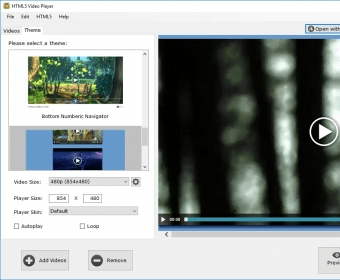
- #Html5 video player streaming how to#
- #Html5 video player streaming install#
- #Html5 video player streaming update#
- #Html5 video player streaming code#
- #Html5 video player streaming Pc#
This is a requirement for any premium subscription video service. The W3C Encrypted Media Extensions specification “extends HTMLMediaElement providing APIs to control playback of protected content.” The video content we stream to customers is protected with Digital Rights Management (DRM).

Perhaps best of all, we can iterate on and improve our content delivery and adaptive streaming algorithms in JavaScript as our business needs change and as we continue to experiment. In addition, this allows us to implement our industry-leading adaptive streaming algorithms (real-time selection of audio/video bitrates based on available bandwidth and other factors) in our JavaScript code.
#Html5 video player streaming how to#
Since we can control how to download the audio/video content in our JavaScript code, we can choose the best HTTP server to use for content delivery based on real-time information, and we can implement critical behavior like failing over to alternate servers in the event of an interruption in content delivery. The W3C Media Source Extensions specification “extends HTMLMediaElement to allow JavaScript to generate media streams for playback.” This makes it possible for Netflix to download audio and video content from our content delivery networks and feed it into the video tag for playback. We call these, collectively, the “HTML5 Premium Video Extensions”: Media Source Extensions (MSE) Over the last year, we’ve been collaborating with other industry leaders on three W3C initiatives which are positioned to solve this problem of playing premium video content directly in the browser without the need for browser plugins such as Silverlight. We’re interested to solve these problems as we move to our next generation of video playback on the web. Third, not all browsers support plugins (eg: Safari on iOS, Internet Explorer in Metro mode on Windows 8), so the ability to use them across a wide range of devices and browsers is becoming increasingly limited.
#Html5 video player streaming install#
Second, some view browser plugins as a security and privacy risk and choose not to install them or use tools to disable them. For some customers, Netflix might be the only service they use which requires the Silverlight browser plugin. First, customers need to install the browser plugin on their computer prior to streaming video. Silverlight is a browser plugin which allows our customers to simply click “Play” on the Netflix website and watch their favorite movies or TV shows, but browser plugins have a few disadvantages. We’d like to share some progress we’ve made towards our goal of moving to HTML5 video. But since Microsoft announced the end of life of Silverlight 5 in 2021, we need to find a replacement some time within the next 8 years.

It provides a high-quality streaming experience and lets us easily experiment with improvements to our adaptive streaming algorithms.
#Html5 video player streaming Pc#
We currently use Microsoft Silverlight to deliver streaming video to web browsers on the PC and Mac. It’s pretty exciting to see HTML5 bring all these features to the client side.By Anthony Park and Mark Watson Today, we’re excited to talk about proposed extensions to HTML5 video that enable playback of premium video content on the web.
#Html5 video player streaming code#
I think the code is written much better now and you check it out over here. In terms of my “screenshots from video” script, I decided to rewrite that from scratch as I wanted to improve the error handling and make some other enhancements.
#Html5 video player streaming update#
I have update my “animated GIF maker” script to only use a Blob and I was able to make a GIF out of a really large video. Thus, you can now load and play really large local video files in your browser without crashing. As the browser loads more of the video data, this gets passed into the video tag. This url is then assigned to the video tag and it starts playing the video right away. It turns out that I can skip FileReader completely and create a blob Url out of the user provided video instantly. But, reading the entire file is not necessary as both the video and audio tag support a file stream. When the user dropped or selected a local video file, I read that entire file using the FileReader API and then created a Blob URL out of it so that it can be used in the HTML5 video tag.

It basically crashed my Chrome tab and after looking at my code again, this makes sense. I have written a few demos on using the HTML5 video tag, showing how you can make screenshots from movies or create animated GIFs, but last night I noticed some major issues with loading a large local video file.


 0 kommentar(er)
0 kommentar(er)
